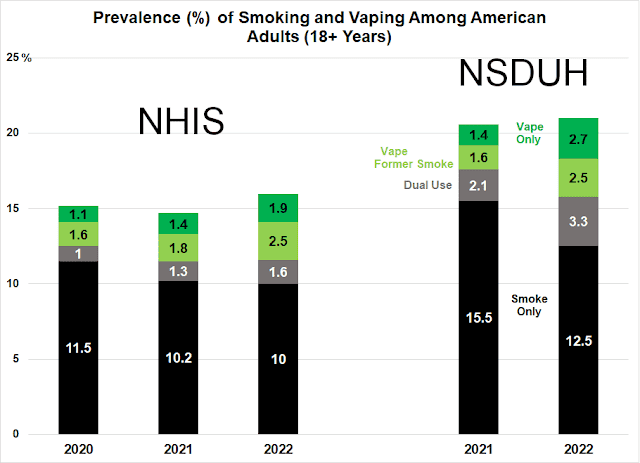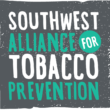
Recently I described how high school vaping rates reported
in the National Survey on Drug Use and Health (NSDUH) are much lower than those
reported in the CDC’s National Youth Tobacco Survey (NYTS) (here). Today I review NSDUH adult vaping rates,
compared to those in the National Health Interview Survey (NHIS), which is the
CDC’s traditional source for adult smoking estimates.
The chart at left shows smoking and vaping rates among all
American adults 18+ years. In 2022, the
NHIS estimate of current smokers was 11.6%, or about 29 million.
Now let’s turn to vaping, keeping in mind that the “Dual
Use” column segments count both current vaping and smoking. In 2022, the NHIS estimate of current vapors was
6%, or nearly 15 million, including almost 4 million dual users.
As I demonstrated in a 2009 published analysis (here),
NSDUH current smoking estimates are always higher than NHIS estimates. Neither survey estimate is right or wrong;
instead, taken together, they probably represent a reasonable range. The 2022 NSDUH percentage of smokers was 15.9%,
or about 39.5 million, while the NSDUH vaping prevalence for that year was 8.5%
or 21 million, with 8.1 million dual users.
Turning to young adults 18-24 years old, in 2022 the NHIS
estimate of current smokers in this group was 4.8% or about 1.4 million, but
the vaping prevalence was even higher, at 15.1%, representing 4.3 million. This means that vaping surpassed smoking among
young adults. The proportions are the
same in NSDUH, even though the numbers are higher: the percentage of smokers is
10.6%, or about 3.7 million, figures that are swamped by the percentage of
vapers, at 24.3%, or 6.9 million.
Why are NSDUH smoking and vaping estimates always higher
than those in NHIS? First, the surveys
ask different questions to account for “current” use. As we noted in our previous
study, “NSDUH identifies almost twice as many some-day smokers as the NHIS,
which is likely due to differences in the questions that subjects are
asked.” But we also discussed an even
more important factor: “the respondents’ perceptions of smoking within the
context of the two surveys. The NHIS is focused on the health status of
participants, with more limited attention on behavioral risk factors. In this
context, smoking may be perceived as one of the more undesirable behaviors that
subjects are asked to report, which may lead to under-reporting. In contrast, the NSDUH is devoted almost
entirely to substance use, with questions about marijuana, cocaine and crack
cocaine, hallucinogens, inhalants and non-medical use of prescription drugs. In
the context that these substances are far more socially unacceptable than
cigarettes, participants may be more comfortable acknowledging that they
smoke.”
Fifteen years ago, we wrote, “It is surprising that
estimates of national smoking prevalence have been derived from a single
source, the NHIS, and that little research has been conducted to assess its
accuracy over time… Further investigation of the NSDUH/NHIS discrepancy may
lead to better surveys and an improved understanding of smoking trends in the
USA.”
To date, nothing has been done to explain this discrepancy,
so it is reasonable to consider the NHIS and NSDUH figures as low and high
estimates for U.S. smoking and vaping.





